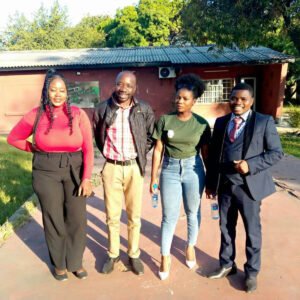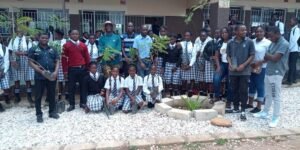Strategic Objectives, Goals and Targets
- >
- Strategic Objectives, Goals and Targetsb
Objective 1: Empower Young Leaders in Kafue Sub-Basin
- Goal 1.1: Train 5000 young leaders from Kafue Sub-Basin in environmental governance and policy reform by 2030.
- Target 1.1.1: Identify and recruit 500 young leaders from local communities by 2025.
- Target 1.1.2: Develop and implement a comprehensive training program on environmental governance and policy reform by 2026.
- Target 1.1.3: Establish a mentorship program pairing young leaders with experienced environmental professionals by 2027.
- Goal 1.2: Establish a youth-led environmental advocacy group in Kafue Sub-Basin by 2026.
- Target 1.2.1: Conduct a needs assessment and feasibility study on establishing a youth-led advocacy group by 2024.
- Target 1.2.2: Develop a business plan and secure funding for the advocacy group by 2025.
- Target 1.2.3: Launch the advocacy group and recruit 2000 youth members by 2026.
- Goal 1.3: Support 20 youth-led environmental projects in Kafue Sub-Basin by 2030.
- Target 1.3.1: Identify and select 10 youth-led project proposals for funding by 2026.
- Target 1.3.2: Provide technical assistance and mentorship to project leaders by 2027.
- Target 1.3.3: Evaluate project impact and scalability by 2028.
Objective 2: Restore Water and Aquatic Ecosystems in Kafue Sub-Basin
- Goal 1: Engage youth in sustainable fisheries and aquaculture practices
- Target 1.1: Train 50 youth fishing groups in sustainable fishing and aquaculture methods by 2030.
- Target 1.2: Establish 50 youth-led aquaculture projects by 2030
- Goal 2: Improve water management and efficiency
Strategic goals and targets focus on safeguarding water and aquatic food systems, promoting sustainable fisheries, aquaculture ecosystems, and water management practices.
- Target 2.1: Install rainwater harvesting systems in 50 schools and 50 communities by 2030
- Target 2.2: Implement water-saving technologies in 25 agricultural operations by 2030
- Goal 3: Protect and restore aquatic ecosystems
- Target 3.1: Organize 50 community clean-up events, engaging 5000 youth, by 2030
- Target 3.2: Restore 500 hectares of degraded wetlands and habitats by 2030
- Goal 4: Promote sustainable water and aquatic food systems awareness.
- Target 4.1: Develop and disseminate educational materials to 500 youth and community members within 3 months
- Target 4.2: Organize 5 awareness events, engaging 100 youth and community leaders, within 6 months
- Goal 5: Support youth-led entrepreneurship and innovation
- Target 5.1: Provide seed funding and mentorship to 10 youth-led sustainable aquaculture and water management projects within 1 year
- Target 5.2: Establish a youth-led innovation hub, supporting 20 young innovators, within 2 years
Objective 3: Promote Regenerative Agriculture in Kafue Sub-Basin
Goals and targets for this strategic objective focus on transforming agriculture and foodscapes, ensuring regenerative, resilient, and equitable food systems:
- Goal 1: Promote Regenerative Agriculture Practices in Kafue Sub-Basin
- Target 1.1: Train 50 youth farmer groups in regenerative agriculture methods, focusing on conservation agriculture and agroforestry by 2030
- Target 1.2: Establish 50 youth-led regenerative agriculture demonstration plots in different districts of Kafue Sub-Basin within by 2030
- Goal 2: Support Equitable Food Access in Kafue Sub-Basin
- Target 2.1: Develop and implement a food distribution system, reaching 20,000 households in rural areas, by 2030.
- Target 2.2: Establish 50 youth-led community gardens in different districts, providing fresh produce to 20000 families, by 2030
- Goal 3: Foster Resilient Food Systems in Kafue Sub-Basin
- Target 3.1: Develop and implement a climate-resilient agriculture plan, engaging 50 youth groups, by 2030
- Target 3.2: Establish 30 youth-led agroforestry projects, promoting biodiversity and ecosystem services, by 2030
- Goal 4: Empower Youth-Led Entrepreneurship in Kafue Sub-Basin
- Target 4.1: Provide seed funding and mentorship to 20 youth-led sustainable agriculture and food business projects by 2030
- Target 4.2: Establish a youth-led innovation hub, supporting 100 young entrepreneurs, by 2030
- Goal 5: Raise Awareness and Advocate for Policy Change in Kafue Sub-Basin
- Target 5.1: Organize 10 awareness events, engaging 5000 youth and community leaders, by 2030
- Target 5.2: Develop and advocate for policy changes, supporting regenerative and equitable food systems, within 1 year
Objective 4: Preserve Forests in Kafue Sub-Basin
Strategies, goals and targets focus on protecting and restoring forests, preserving biodiversity, ecosystem services, and indigenous knowledge:
- Goal 1: Protect and Restore Forests
- Target 1.1: Establish 50 youth-led community forestry groups, managing 10,000 hectares of forest, by 2030
- Target 1.2: Plant 5,000,000 tree seedlings, promoting native species, by 2030
- Goal 2: Preserve Biodiversity
- Target 2.1: Conduct biodiversity surveys, identifying priority species, by 2030
- Target 2.2: Develop and implement conservation plans, protecting priority species, by 2030
- Goal 3: Preserve Ecosystem Services
- Target 3.1: Establish 30 youth-led eco-clubs, promoting sustainable land use practices, by 2030
- Target 3.2: Implement sustainable agriculture practices, reducing soil erosion by 30%, by 2030
- Goal 4: Preserve Indigenous Knowledge
- Target 4.1: Document and preserve traditional knowledge, interviewing 2000 indigenous elders, by 2030
- Target 4.2: Establish a youth-led cultural center, promoting indigenous knowledge and practices, 2030
- Goal 5: Empower Youth Leadership
- Target 5.1: Provide training and mentorship, empowering 2000 youth leaders, by 2030
- Target 5.2: Establish a youth-led steering committee, overseeing project implementation, by 2030.
Objective 5: Driving EPR in the basin
Strategic goals and targets focused on driving extended producer responsibility, circular economy, and waste reduction:
- Goal 1: Promote Extended Producer Responsibility
- Target 1.1: Engage 100 companies in adopting extended producer responsibility practices, by 2030.
- Target 1.2: Establish a producer responsibility youth movement, managing waste from 100 companies, by 2030.
- Goal 2: Foster a Circular Economy
- Target 2.1: Develop and implement a circular economy business model, engaging 150 youth entrepreneurs groups.
- Target 2.2: Establish a circular economy hub, providing training and resources for 150 businesses, by 2030
- Goal 3: Reduce Waste
- Target 3.1: Implement a waste reduction and recycling program, reducing waste by 30%, by 2030.
- Target 3.2: Establish a waste management system, serving 5000 households and businesses.
- Goal 4: Educate and Raise Awareness
- Target 4.1: Conduct awareness campaigns, reaching 1,000 youth and community members, within 6 months
- Target 4.2: Develop and implement an environmental education program, engaging 200 schools, by 2030
- Goal 5: Empower Youth Leadership
- Target 5.1: Provide training and mentorship, empowering 1500 youth leaders, by 2030
- Target 5.2: Establish a youth-led steering committee, overseeing project implementation, by 2030.
Y4ER objectives, goals and Targets are designed to reduce the pressure on the Kafue Sub-Basin and align with Y4ER vision statement, focusing on empowering young leaders, restoring ecosystems, promoting regenerative agriculture, preserving forests, and fostering circular economies.
Conservation Focus: Habitat Conservation and Restoration, with a specific emphasis on:
Aquatic Ecosystems
– River Conservation:
Protecting and restoring river line habitats for aquatic species by maintaining river flow and water quality and also reducing pollution from agricultural runoff and industrial activities.
Wetland Conservation:
Protecting and restoring wetland habitats for water-birds and other species by maintaining wetland hydrology and water quality and Reducing wetland degradation and conversion to agricultural land.
Forest Ecosystems:
Y4ER focus on Protecting and restoring the miombo and mopane woodlands habitats for species like the African elephants and lions whilst maintaining the woodlands structure and composition, reducing deforestation and degradation from agricultural expansion and charcoal production.
Sustainable Land-Use Practices:
Regenerative Agriculture:
Promoting practices like no-till farming cover cropping, and crop rotation this will improve soil health and reducing erosion and Increase biodiversity and ecosystem services.
Agroforestry:
Integrating trees into agricultural landscapes by Promoting practices like silvopasture and silvopoultry which will improve soil health and reducing erosion.
Sustainable Livestock Management:
Promoting practices like rotational grazing and livestock watering points this will improve range-land health and reducing overgrazing and will Increase biodiversity and ecosystem services.
Circular Economy and Extended Producer Responsibility:
Y4ER strategic focus is on Promoting sustainable packaging and reducing waste Encouraging recycling and up cycling of materials. Implementing extended producer responsibility for manufacturers and producers and encouraging the use of recycled materials in production processes.
Community Engagement and Education:
Community-Led Conservation:
Y4ER strategic focus is on Supporting community-led conservation initiatives, Empowering communities to manage natural resources sustainably and Building capacity for conservation and management.
Environmental Education and Awareness:
Y4ER strategic focus is on Promoting environmental education in schools and communities, raising awareness about conservation and sustainability and Encouraging community involvement in conservation efforts.
Y4ER strategic plan on the conservation focus incorporates circular economy and extended producer responsibility principles to reduce waste, promote sustainable practices, and encourage responsible resource management. By addressing these additional aspects, the Strategy aims to further reduce its environmental footprint and promote sustainable development in the Kafue Sub-Basin. The conservation focus also outlines specific priorities and strategies for habitat conservation and restoration in the Kafue Sub-Basin.
Target Audience:
Youth male and female, Local communities, indigenous peoples, and the wildlife in the Kafue Sub-Basin.
Primary Beneficiaries:
Local communities will direct benefit from conservation efforts, including improved livelihoods and environmental sustainability. Indigenous peoples will have direct benefit of cultural preservation and protection of traditional lands and the Wildlife will Direct benefit from habitat conservation and protection.
Stakeholders:
The Governments National and local governments will be responsible for policy-making and resource allocation. Donors from International organizations and foundations will provide funding support, the NGOs Non-governmental organizations working on conservation and development are key and not excluding the Private sector partners who are Companies operating in the Kafue Sub-Basin, including agriculture, mining, and tourism.
Partners:
The Local organizations such as Community-based organizations and local NGOs working on conservation and development, Research institutions Universities and research centers providing scientific support and expertise, Community groups: Local groups and associations representing community interests and needs.
Needs Assessment:
The Kafue Sub-Basin faces various conservation challenges and gaps, including:
- Habitat loss and fragmentation due to agriculture, urbanization, and infrastructure development.
- Overfishing and destructive fishing practices threatening aquatic biodiversity.
- Insufficient protected areas and ineffective management of existing ones.
- Limited community engagement and awareness about conservation importance.
- Inadequate waste management and pollution from agricultural runoff and industrial activities.
- Lack of sustainable livelihood options for local communities, leading to dependence on natural resources.
- Insufficient research and monitoring of biodiversity and ecosystem health.
- Limited capacity and resources for conservation efforts among local organizations and communities.
- Inadequate policy and legislative frameworks to support conservation efforts.
- Limited access to funding and resources for conservation initiatives.
To address these needs and gaps, the strategic plan will focus on:
- Habitat protection and restoration.
- Sustainable fishing practices and fisheries management.
- Community engagement and education.
- Waste management and pollution reduction.
- Sustainable livelihood options and economic empowerment.
- Research and monitoring.
- Capacity building and resource support.
- Policy and legislative framework development.
- Funding and resource mobilization.
By addressing these needs and gaps, the Strategic plan aims to achieve effective conservation outcomes and sustainable management of the Kafue Sub-Basin’s natural resources.
| M | T | W | T | F | S | S |
|---|---|---|---|---|---|---|
| 1 | 2 | 3 | 4 | 5 | ||
| 6 | 7 | 8 | 9 | 10 | 11 | 12 |
| 13 | 14 | 15 | 16 | 17 | 18 | 19 |
| 20 | 21 | 22 | 23 | 24 | 25 | 26 |
| 27 | 28 | 29 | 30 | 31 | ||



